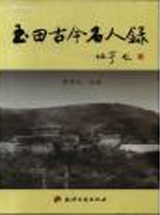
主要责任者: 李作仁;兰崇双,高世兴,裴致钧
责任方式: 主编;副主编
出版者: 天津古籍出版社
出版地: 天津
字数: 326 千字
页码: 1-391
开本: 16
中图分类号: K820.822.4
装帧: 简
语种:中
定价:39.80
出版时间:2007-08
丛书多卷书否:否
书目简介:本册工具书共收录89条词条。
被引频次:4
| 词条 | 玉田古今名人录 |
| 类别 | 中文百科知识 |
| 释义 |  主要责任者: 李作仁;兰崇双,高世兴,裴致钧 责任方式: 主编;副主编 出版者: 天津古籍出版社 出版地: 天津 字数: 326 千字 页码: 1-391 开本: 16 中图分类号: K820.822.4 装帧: 简 语种:中 定价:39.80 出版时间:2007-08 丛书多卷书否:否 书目简介:本册工具书共收录89条词条。 被引频次:4 |
| 随便看 |
开放百科全书收录579518条英语、德语、日语等多语种百科知识,基本涵盖了大多数领域的百科知识,是一部内容自由、开放的电子版国际百科全书。